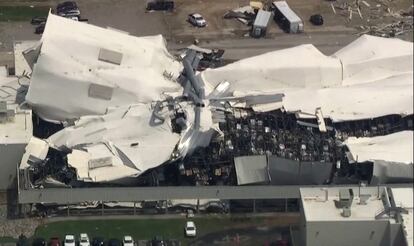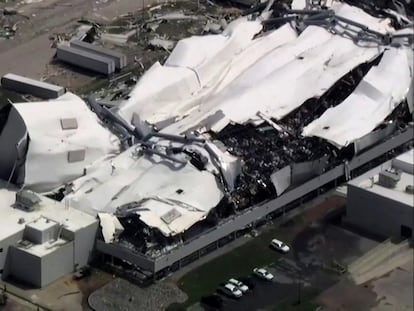Tornado damage to Pfizer plant will probably create long-term shortages of some drugs hospitals need
Experts say the damaged plant could lead to a supply disruption while Pfizer figures out next steps. Those could include shifting production to another location

The fallout from a Pfizer factory being damaged by a tornado could put even more pressure on already-strained drug supplies at U.S. hospitals, experts say.
Wednesday’s tornado touched down near Rocky Mount, North Carolina, and ripped up the roof of a Pfizer factory that makes nearly 25% of Pfizer’s sterile injectable medicines used in U.S. hospitals, according to the drugmaker.
Pfizer said all employees were safely evacuated and accounted for, and no serious injuries were reported. The drugmaker is still assessing damage.
Here’s a closer look at the possible effects.
What are sterile injectables?
The North Carolina plant produces drugs that are injected or through an IV.
The plant makes drugs for anesthesia, medicines that treat infections and drugs needed for surgeries. The latter are used in surgeries or intensive care units for patients who are placed on ventilators, said Mike Ganio, who studies drug shortages at the American Society of Health-System Pharmacists.
The Pfizer site does not make or store the company’s COVID-19 vaccine or treatments Comirnaty and Paxlovid.
How big is the site?
Pfizer bought the eastern North Carolina factory in 2015 as part of its acquisition of the drugmaker Hospira.
There is more than 1.4 million square feet of manufacturing space, or the equivalent of more than 24 football fields, and 22 packaging lines.
Pfizer says well over 2,000 people work there.
How will this affect hospital drug supplies?
It will likely lead to some long-term shortages while Pfizer shifts production to other locations or rebuilds, said Erin Fox, senior pharmacy director at University of Utah Health.
“If Pfizer falls out, it makes it that much harder for other companies to make up the difference,” Fox said.
The specifics of which drugs might be involved in a shortage and how long that shortage will go aren’t clear.
“Anyone who is aware of this event is basically holding their collective breath at this point, hoping for the best and waiting for news,” Ganio said.
He noted that drugmakers tend to ship finished products quickly from manufacturing sites, which may limit how much inventory was damaged by the twister.
How can hospitals handle shortages?
They have several tools to soften the impact for patients.
Some hospitals have started increasing inventories of stored drugs instead of relying on regular deliveries from a wholesaler. Ganio said that it’s particularly true of drugs that hospital executives know will be hard to get.
Hospitals also may switch to different forms of a drug by giving a patient an antibiotic pill instead of an IV if that person can handle it. If a larger vial size of a drug is more readily available, they may order that and then fill several syringes with smaller doses ready for use.
Aren’t hospitals already dealing with drug shortages?
Yes, it’s been happening for years. But recently, hospitals have been dealing with shortages for things like chemotherapy drugs, pain medications and local anesthetics.
The impact of drug shortages isn’t limited to hospitals. The also affect more routine care delivered through drugstores and doctor’s offices.
Overall, there were 309 active drug shortages in the U.S. at the end of June, according to the University of Utah Drug Information Service. That’s up from 295 at the end of last year and the highest total recorded since 2014.
What will Pfizer do?
The company hasn’t said what happens next. Pfizer CEO Albert Bourla said Thursday on Twitter that the company was “working urgently to determine the best way to get back online as quickly as possible, while ensuring the safety of our people.”
Drugmakers can shift manufacturing to other locations. But that can be complicated because they must reroute raw materials — usually made elsewhere — to other locations and may have to train workers to make a product.
Pfizer also may have to figure out whether to cut production of another product to squeeze in more manufacturing at the new site.
“It’s not always as easy as just flipping a switch to increase production,” Ganio said.
Sign up for our weekly newsletter to get more English-language news coverage from EL PAÍS USA Edition
Tu suscripción se está usando en otro dispositivo
¿Quieres añadir otro usuario a tu suscripción?
Si continúas leyendo en este dispositivo, no se podrá leer en el otro.
FlechaTu suscripción se está usando en otro dispositivo y solo puedes acceder a EL PAÍS desde un dispositivo a la vez.
Si quieres compartir tu cuenta, cambia tu suscripción a la modalidad Premium, así podrás añadir otro usuario. Cada uno accederá con su propia cuenta de email, lo que os permitirá personalizar vuestra experiencia en EL PAÍS.
¿Tienes una suscripción de empresa? Accede aquí para contratar más cuentas.
En el caso de no saber quién está usando tu cuenta, te recomendamos cambiar tu contraseña aquí.
Si decides continuar compartiendo tu cuenta, este mensaje se mostrará en tu dispositivo y en el de la otra persona que está usando tu cuenta de forma indefinida, afectando a tu experiencia de lectura. Puedes consultar aquí los términos y condiciones de la suscripción digital.
More information
Archived In
Últimas noticias
Most viewed
- Reinhard Genzel, Nobel laureate in physics: ‘One-minute videos will never give you the truth’
- Oona Chaplin: ‘I told James Cameron that I was living in a treehouse and starting a permaculture project with a friend’
- Pablo Escobar’s hippos: A serious environmental problem, 40 years on
- Why we lost the habit of sleeping in two segments and how that changed our sense of time
- The fall of a prolific science journal exposes the billion-dollar profits of scientific publishing










































